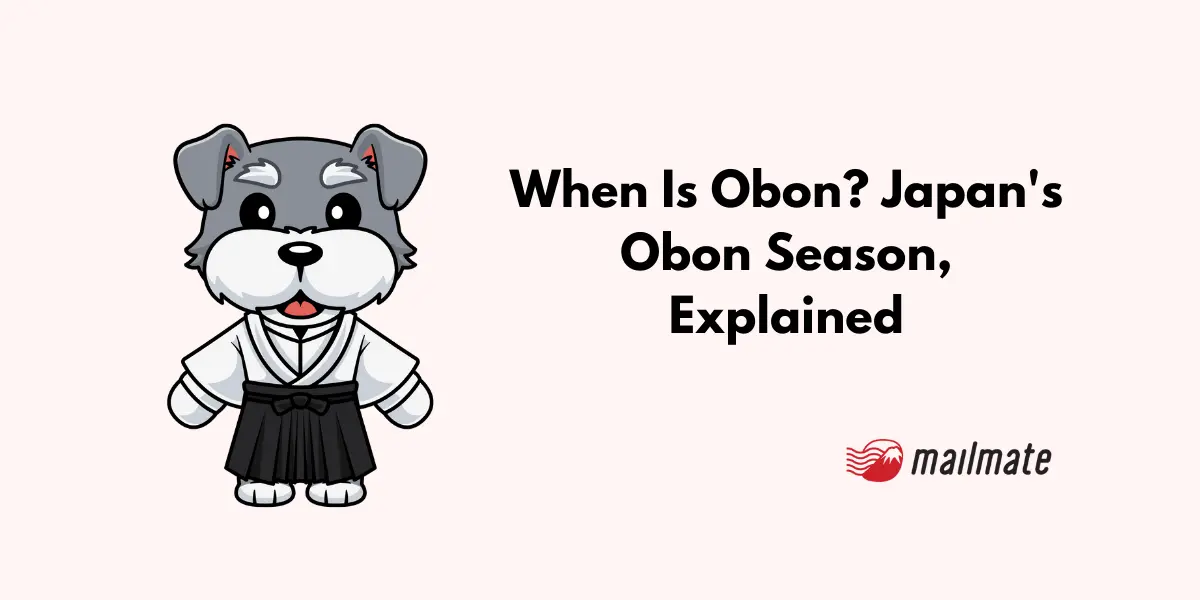When Is Obon? Japan's Obon Season, Explained

Every year during obon, August 13 to 16, many people return to their parents' hometown to visit their family's graves and make offerings.
This article looks at Japan's obon = お盆: its origins, history, and how it is observed nationwide to increase your enjoyment and understanding of the upcoming season.
What is Japan's obon season?
Honoring of one's ancestors remains a predominant tradition throughout Japan. During obon season, tradition has it that one's family's deceased members return to earth where they are welcomed into one's home and worshiped.

Customs include lighting welcome and farewell fires, making offerings, cleaning deceased family members' graves, and performing a bon odori to entertain the ancestors prior to their return to the spirit world.
What are the origins of obon?
The official name of obon is 盂蘭盆会 = urabone or 盂蘭盆= urabon. One theory has it that the word "urabon" is derived from the Sanskrit word Ullambana, which means "the pain of hanging upside down."
According to certain traditions, the sutra that influenced obon traditions describes a disciple of the Buddha who learns his late mother is being hanged upside down in hell.
Hoping to save her, he asks the Buddha for advice and Buddha replies, "If you make offerings from your heart to many high priests on the 15th day of the seventh month of the lunar calendar [around the middle of August in the present day], you will be able to save your mother from suffering.”

The disciple does as instructed and gives offerings to Buddhist monks and is able to release his mother's spirit from suffering and celebrates by dancing with joy—this dance is believed to be the origins of the bon odori.
It is said that after this sutra was introduced to Japan, the obon festival began, including visits to graves and the lighting of welcome fires to express gratitude to the ancestors.
The Japanese kanji 盆 = bon also describes a container for placing offerings. Through the passage of time, it has also become a name for the spirits who are enshrined. In some places, spirits are called bon-sama.
When is obon celebrated?
Currently, there are two primary dates when obon is observed: July 15 and August 15. The reason for this is that when Japan's calendar was modernized during the Meiji era, some areas held the event on July 15 of the new calendar, while others held it in August to keep with tradition.
In Tokyo, many wards hold the ceremony in July, but the most common period nationwide is said to be the four days from August 13 to August 16.
The calendar of events for obon celebrations generally looks like this:
August 13: Welcoming one's ancestors
August 14 - 15: Visiting graves and making offerings
August 16: A farewell fire for one's ancestors
The bon odori festival may take place on any day throughout August 13 and 16.
Is obon a national holiday?
While many citizens take time off to return home for this Buddhist festival, obon is not an official holiday.

What is mukaebi and okuribi?
The welcome fire, 迎え火 = mukaebi, is lit on the evening or the night of August 13 to mark the return of one's ancestors to this world, helping to guide them so they do not get lost.
The farewell fire, 送り火 = okuribi, follows the same pattern as mukaebi, except it is burned on August 16, as a farewell to the ancestors who have spent time with us during obon.

Today, ogara (hemp stalks) are burned or lanterns are lit in place of actual fires, often at the threshold of one's house or leading to one's ancestors' graves.
What type of offerings do individuals make during obon?
Obon offerings お盆のお供え物 = obon no osonaemono are unique to each region. In many areas, eggplant and cucumbers are displayed, but this is not a nationwide practice. Baskets of fruits or the ancestors' favorite snacks are also often chosen.
Offerings will differ from household to household, but the purpose of all of them is to honor the spirits of one's ancestors.
What is bon odori or an obon festival?
Bon odori 盆踊り, which means "bon dance," is usually held on August 15, the night before one's ancestors return to the other world, and it is often seen as an event to entertain them before they leave.
While it is widely believed the origins of the bon dance have Buddhist roots, the folk dance soon transitioned to a local folk entertainment, where citizenry reveled in costumes, choreography, and music, and by the beginning of the Muromachi period (1333–1573), people began to beat drums and dance, and the festival transitioned to what is quite similar to its modern form.
Additionally, some traditions point to bon dances as a ritual to pray for a good harvest, as well as express gratitude to Mother Nature.
What happens during a bon odori festival?
There are many variations to the bon dance, depending on your region. Music and dance steps will also depend on your region and city. In some areas, the dancers are predetermined, but for the most part it is generally understood that anyone and everyone can join in.
Many festival goers don yukata (although it is not required) and dance around a yagura (raised stage), which functions as a stand for Japanese taiko drums and singers, who perform mostly traditional songs. Recently, anime and pop music also make their way into the evening's playlist.
Outside of music and dancing, festival spots often include a line of stalls that sell Japanese street food and other treats, toys, and games for children to play.
For a listing of nationwide obon festivals, check out this page on Walkerplus.
Is China's Hungry Ghost Festival related to obon in Japan?
China's Hungry Ghost Festival and Japan's Obon Festival share similar roots and themes, but the two traditional festivals are celebrated differently.
Both festivals are based on Buddhist and Taoist traditions and involve paying respects to ancestors and the deceased. They both occur around the same time of year and involve rituals intended to appease the spirits of the deceased, who are believed to visit the world of the living during this time.
In China's Hungry Ghost Festival, tradition goes that hell's gates are opened and ghosts are free to walk the earth, seeking food and entertainment. These ghosts are said to be ancestors of those who did not pay tribute to them after they died. People appease these hungry ghosts by offering food and burning 'hell money' and other forms of joss paper.
On the other hand, during Japan's Obon Festival, it's believed that the spirits of ancestors return to visit their relatives. Japanese people clean their houses and light lanterns to guide the spirits home, make food offerings, and visit their ancestors' graves. At the end of obon, floating lanterns are put into rivers, lakes and seas to guide the spirits back to the world of the dead.
So, while they share common themes of ancestor veneration and the belief in the mobility of spirits during a certain time of year, the specific customs and beliefs associated with the Hungry Ghost Festival and Obon are distinct to their respective cultures.
Bonus: Japan's summer greeting cards have obon origins
Japan's summer greeting cards 暑中見舞い = shochumimai are said to originate in obon customs.
This summer manners guide published by Japan Post describes how during the Edo period (1603–1868) people would bring gifts to the spirits of their ancestors when they returned home for obon.
For those homes that were too far away to visit, gifts and letters were sent in their stead. And with the development of the postal system in 1873, this custom of giving and receiving gifts was simplified into the custom of sending greeting cards. In the Taisho era (1912–1926), the current form of summer greeting cards was established.
Frequently asked questions
When is Obon?
The official dates are usually from August 13th to 15th. Some regions celebrate it between July 13th and 15th. The dates may sometimes vary depending on where you are in Japan.
What is Obon season?
Obon season is a major holiday period in Japan, usually taking place between July and September. Obon travel peak is anticipated to take place between August 5 and August 20. During this time, many Japanese people travel and get together to honor their ancestors and loved ones who have passed away.
How is Obon celebrated?
Obon is a traditional festival celebrated with various customs. Families who celebrate Obon usually gather in their hometowns, visit gravestones, perform rituals, and attend festivals. However, not every family follows the same customs.
Does Obon vary by region in Japan?
The celebration of Obon can vary by region. For instance, in Tokyo, Obon is celebrated around the 15th of July, while in other parts of the country, it's celebrated around the 15th of August. Some regions, like Okinawa, may have slightly different dates.
What is the significance of Obon?
Obon is one of Japan's most important festivals. It is a time to honor and remember the spirits of ancestors and loved ones who have passed away. The festival is marked by various traditions and customs, including visiting family graves and participating in the bon odori dance.
In closing
As we approach the Obon season, understanding its origins, significance, and associated customs can enhance our appreciation of this profound tradition. Whether you're participating in the festivities or simply observing, Obon offers a unique insight into Japanese culture and the enduring respect they hold for one's ancestors.
Spending too long figuring out your Japanese mail?
Virtual mail + translation services start at 3800 per month. 30-day money-back guarantee.








